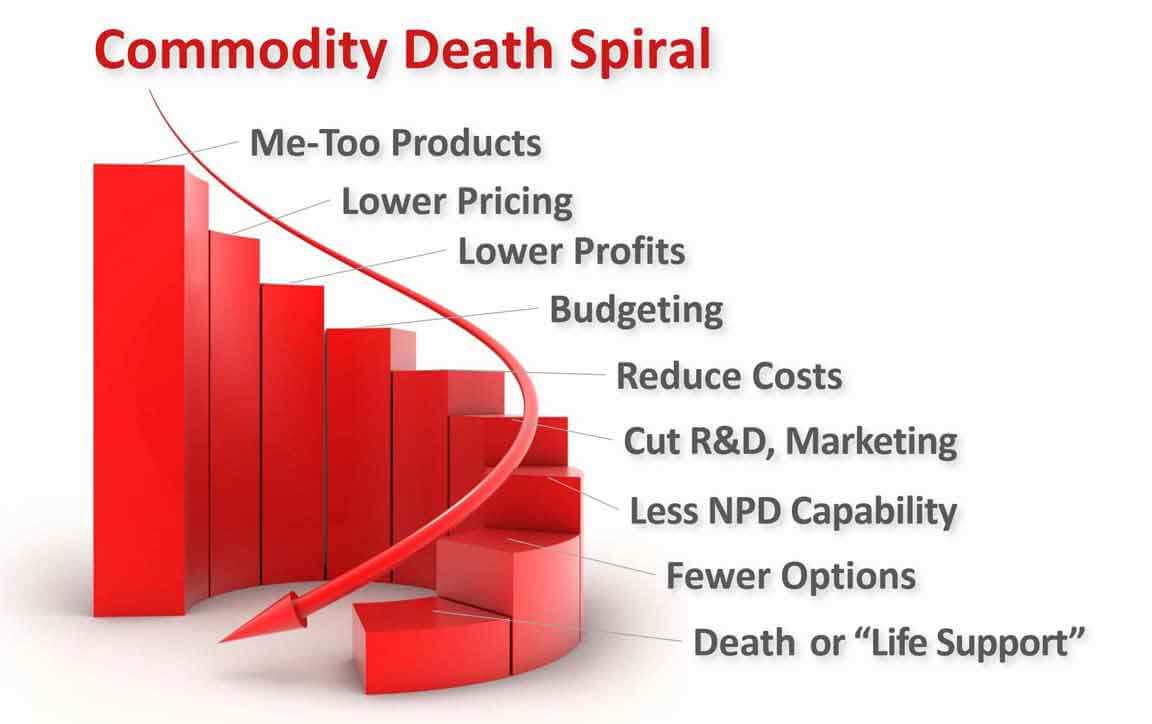Beyond Incremental New Products: Avoid the Commodity Death Spiral

Imagine your business has been mostly developing me-too and incremental new products. Your products start looking a lot like competitors’—a fact that does not go unnoticed by your customers’ purchasing agents. Since they can interchange your products with competitors’ products, they’re able to pressure you for lower prices.
Incremental New Products are Not Enough
Your profits have been declining and now it’s time to prepare next year’s budget. Do you cheerfully tell your boss to expect more profit declines? I’m guessing… no. To salvage next year, you’ve got to reduce costs. But you won’t cut spending in short-term areas needed to meet next year’s budget. You’ll probably cut longer-term costs, like R&D or marketing.

Of course, this means you’ll have less new product development capability… especially for high-impact new products. So when budget time rolls around a year later, you have even fewer options. This is called the death spiral for obvious reasons. Sometimes a business survives, but just on “life support”—where it is no longer relevant.
Six Ways to Avoid This Death Spiral
Here are some tips for avoiding the commodity death spiral when we only develop incremental new products. As is often the case, part of the solution is in new ways of thinking and part is in new ways of behaving:
Forces pulling a supplier toward “specialty” come from the supplier… or they don’t come at all.
- Take ownership of your future. There are many forces pulling your products toward commoditization:
competitors trying to imitate your products, purchasing agents trying to standardize your products… new technologies trying to obsolete your incremental offerings. If you want to move away from commodity toward specialty products, the sobering truth is you will get no help from outside. Forces pulling a supplier toward “specialty” come from the supplier… or they don’t come at all. - Measure your progress. Is your business moving down the commodity death spiral… or reversing direction? Tracking your New Product Vitality Index over time can provide insight. This is the percentage of your total sales from “new” products (typically introduced in the last three to five years). But don’t forget a simpler metric: average selling price. This is how customers “vote” on the value your products deliver relative to the next best alternatives. You can fire out new products at Gatling gun speed, but if this metric keeps dropping, you’re moving toward the big “C.”
- Change your time horizon. In a 1972 Harvard Business Review article, Richard Vancil complained that long-term product development expenses are buried within short-term operating plans… allowing short-sighted business leaders to “raid” funds needed for their future. Does this problem still exist? Consider putting all your budget dollars in either a short-term bucket or a long-term bucket. And make sure someone is watching the long-term bucket. An unhealthy obsession with the short term will eliminate all projects except for incremental new products.
Adams’s Risk Paradox: “A business built on ‘low-risk’ projects is actually at great risk.”
- Work on high-impact products. Some companies play it safe and work on only “low-risk” me-too and incremental new products. But, as shown in the commodity death spiral above, this is the beginning of the end. While each me-too and incremental project may have low risks, a business built only on “low-risk” projects is actually at great risk. So make sure your new product project portfolio has a healthy proportion of high impact new products… products that will deliver significant value to your customers.
- Get out more. While it’s risky to only focus on incremental new products, it’s also dangerous to invest in “great hope” projects: high-stakes gambles with lower odds than management realizes. These pull in lots of manpower, funding, and management attention, and after two or three years often end with a whimper… typically from a fatal flaw that should have been discovered much earlier. So if there’s too much risk with both me-too and great hope projects, what’s the answer? I believe we need to “get out more.” Spend much more time in your customers’ world to reduce your commercial risk. And reduce your technical risk through open innovation… uncovering and introducing technologies from outside your company.
- Directly engage your customers. In its landmark 2007 study, The Global Innovation 1000, Booz Allen Hamilton found companies that directly engage customers in their innovation processes had profit growth three times faster than those using “indirect customer insight.” When we solve customer problems in a meaningful way, by definition, we are pushing beyond incremental new products. In my experience, direct engagement increases as you move from Level 1 to Level 6:
Level 1: Our Conference Room: Deciding what customers want around your conference room table.
Level 2: Ask Our Experts: Polling your sales force, tech service & others to determine customer needs.
Level 3: Customer Survey: Using surveys and polls to ask customers what they want.
Level 4: Qualitative VOC Interviews: Sending interview teams to hear the voice of the customer.
Level 5: Quantitative VOC Interviews: Adding numerical feedback to drive out bias and wishful thinking.
Level 6: B2B VOC Interviews: B2B-optimized methods to fully engage knowledgeable B2B customers.
Here at AIM, we’ve developed the world’s most advanced methods, tools, and software for Level 6 B2B-optimized interviews. To learn more, check out this short video on New Product Blueprinting.
Click here to learn more about AIM’s process for innovation: New Product Blueprinting
Comments